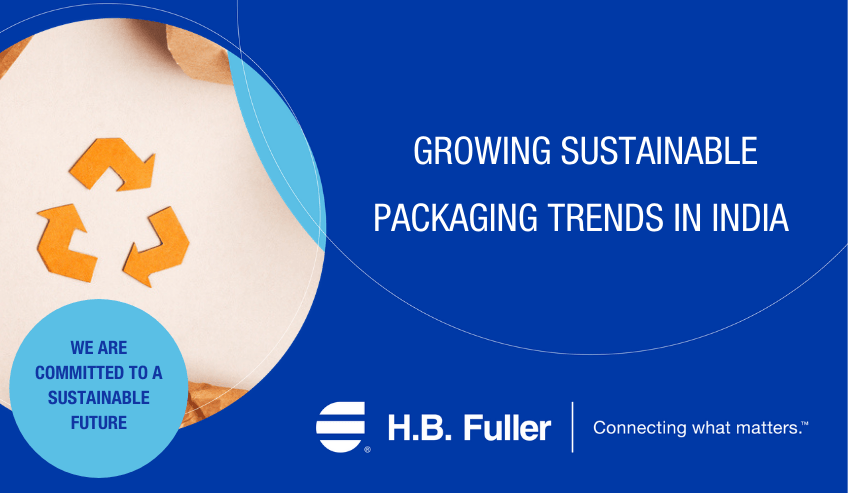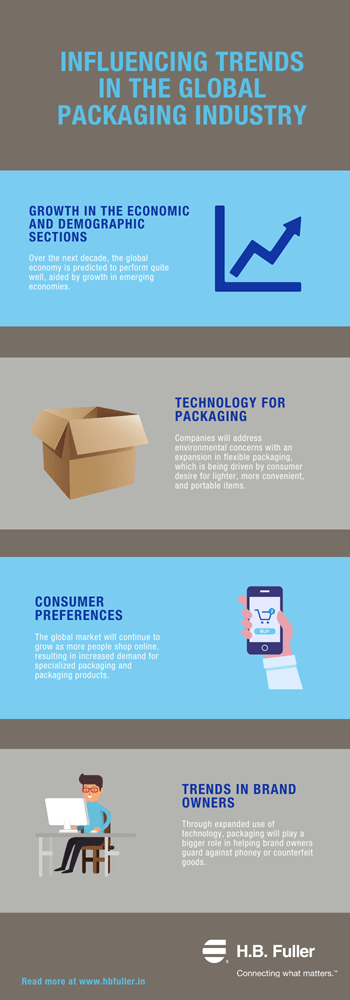
The Glue Talk Blog

The demand for more efficient and environmentally friendly packaging is increasing. Some of the most rapidly expanding brands are ahead of the curve. Many businesses are getting rid of trash-bound products, like packing slips and third-party marketing materials. Sustainability is swiftly gaining traction among businesses, and consumers are increasingly asking for environmentally responsible products. In the developing markets of India and China, in particular, the growing middle class is increasingly aware of health and environmental risks associate with certain packaging, and, therefore, driving this trend. Good environmental performance and business value may coexist, so manufacturers that approach sustainability demands thoughtfully can gain a competitive commercial edge.
According to Smithers' recent report, The Future of Packaging: Long-Term Strategic Forecast to 2028, “the worldwide packaging market is expected to grow by about 3% per year between 2018 and 2028, reaching over $1.2 trillion.” Consumers are increasingly interested in packaging materials and designs that demonstrate a commitment to the environment.
Overview of the Market
Between 2021 and 2026, India's packaging sector is predicted to grow at a rate of nearly 27%. To prevent the spread of the COVID-19 pandemic, most developed countries are either burning wastepaper or using it as landfill (Reference: industry report from Mordor Intelligence). Corrugated cardboard box manufacturers are working to transport packaging to the makers of essential goods, including food and other consumer products, medical and pharmaceutical, tissue, and hygiene products, but for many Indian paper mills, it is increasingly difficult to secure raw materials.
- The demand for packaging is growing due to the rising population, increasing income levels, changing lifestyles, increased media penetration through the internet, television, and the growing economy. More than 49% of the paper produced in India is used for packaging purposes, according to Care Ratings, a leading credit rating business in India.
- Large investments in growth in the pharmaceutical and food and beverage industries are driving the packaging market's rapid expansion.
- The emergence of India’s middle class, the quick expansion of organized retail, the increase of exports, and the advent of India’s e-commerce sector are all aiding growth. Packaging consumption in India has surged by 200% in the last decade, growing from 4.3 kilograms per person per annum (pppa) to 8.6 kg pppa, according to the Indian Institute of Packaging (IIP).
- The government has been contacting industry experts on a regular basis in order to maximize the packaging sector’s potential in India. For example, the Packaging Industry Association of India (PIAI) has been tasked with developing regulations and guidelines that will boost India’s export potential in the global market.
A Sense of Change
Brand owners have continued to prioritize sustainability in their packaging selections.
The move to packs made entirely of recycled materials is being spearheaded by PET beverage bottles:
- Beginning in 2023, Bacardi has pledged to using 80 million plastic bottles manufactured entirely of biodegradable PHA biopolymers, according to Smithers' State of the Packaging Industry 2020.
- Many large FMCG companies have stated that they will make all packaging recyclable by 2025.
With more goods being distributed directly to customers, e-commerce pack recyclability and reuse has become more important. RePack's recycled plastic mailer, for example, can withstand 20 online customer deliveries and is suited for return shipments. A vast amount of packaging material is necessary to package Amazon's five billion items sent worldwide each year. As a result, Amazon developed the Frustration Free Packaging initiative to lessen its environmental impact while also meeting customer needs for less overpacking.
Growth Accelerators
Consumer Awareness
Consumer sentiment has been sparked around the world by emotional visuals of the impact of ocean and sea plastic waste, which is driving changes in the manufacturing process. The Indian packaging sector has grown rapidly during the last decade, owing to changes in substrate selection and the proliferation of alternative solutions. To address customer demand for sustainable materials, the usage of bagasse, maize starch, and PLA as plastic replacements has expanded.
Government Rules and Regulations
Governments all over the world have responded to public concerns about packaging waste, particularly single-use packaging waste, by enacting standards to reduce environmental waste while also improving waste management systems. For the time being, India has deferred plans for a complete ban on single-use plastics in favor of greater plastic waste awareness campaigns and more collection stations to improve waste collection and cut waste.
A Sustainable Future
According to a recent Capgemini report, Sustainability and Changing Consumer Behavior, 79% of consumers are changing their buying preferences due to social responsibility, inclusiveness, or environmental effect. Single-use plastics account for more than 70% of the wrappers wasted and disposed of, which either amass on our ocean floors, pile up in trash mountains, or contribute to carbon emissions. Working together, packaging manufacturers and their suppliers, like H.B. Fuller, are partnering to develop more environmentally friendly packaging products.
Looking how to best serve your customers might be overwhelming as new technologies emerge and larger multinational consumer packaged goods (CPG) firms become more transparent about their sustainability activities. Connecting what matters at H.B. Fuller goes beyond adhesives to matching you with the proper subject matter expert for your sustainable packaging requirements. We lead with adhesives, sealants, and functional coatings technology and solutions that can help solve current and future global environmental and societal concerns. Click here to learn more.

Blog Categories
Blog Categories
Archive
- 2024
- 2023
- 2022
-
2021
- January (3)
-
February (7)
- Celebrating Exceptional Service During COVID-19 Complications
- Cyanoacrylates: What They Are and What They Do
- Innovative two-shot bookbinding adhesive
- Make a Difference 2020
- Problem Solving: Paper Straws in Drinking Beverages
- Stronger straws sustainable future
- Substances of Interest in Disposable Absorbent Hygiene Products
- March (4)
- April (4)
- May (4)
- June (5)
- July (2)
- August (5)
- September (2)
- October (1)
- November (3)
- December (2)
-
2020
- January (4)
- February (2)
- March (3)
- April (4)
- May (3)
-
June (7)
- Community Support in the Era of Coronavirus
- HBFuller Employee Creates Face Shields with 3D Printer
- Improved Packaging Integrity and Greater Customer Satisfaction
- Liquid-Resistant Paper Straws
- What is a Sealant?
- What Is the Future of Commercial Disinfectants?
- Winning over consumers with e-commerce packaging solutions
-
July (6)
- Employees Take Action to be Part of Healing and Growth
- Gain a competitive advantage with packaging adhesive solutions
- HB Fuller Company Foundations Commitment to Communities
- Packaging Solutions for the South African Agriculture Market
- Supporting Organizations That Provide STEM Education for Youth
- Where Does Sustainability Stand Amid COVID-19
- August (3)
- September (2)
- October (4)
- November (2)
- December (4)
